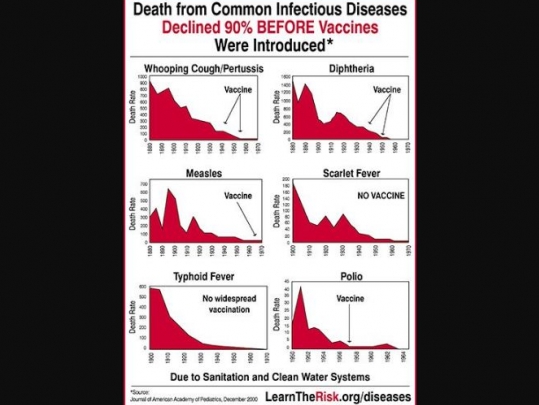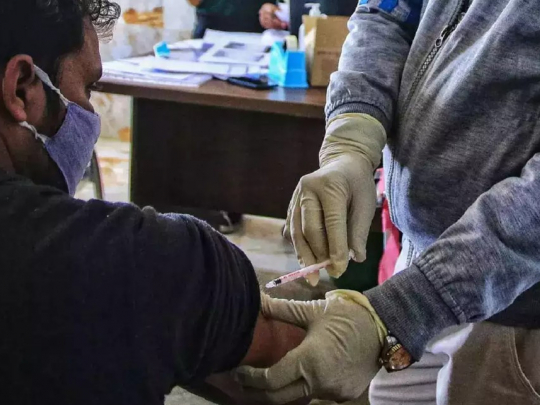The Facts are Clear: Infectious Disease Deaths Declined Nearly 90% Before Vaccines Were Introduced…

In the United States (and other countries), historical records show that disease mortality declined nearly 90% before the introduction of the vaccine program and routine vaccination programs — as stated in the Trends in the Health of Americans report.
In fact, some of the most prevalent diseases in the early 1900s — including Tuberculosis (TB), Scarlet Fever and Typhoid — followed the same declines WITHOUT ever having a vaccine program (in the US). These diseases were nearly eradicated in the U.S. without the population being vaccinated for them. (See graph)
How is this possible? The pharmaceutical/medical industry has spent MILLIONS convincing us that vaccines saved us all from imminent disease death, but history proves this is more of a marketing tactic than a fact. A marketing tactic that helps ensure the nearly $60 BILLION vaccine market keeps growing.
WHY DID DISEASES DECLINE?
The 19th-century population shift from country to city that accompanied industrialization and immigration led to overcrowding in newly populated cities that lacked proper sanitation or clean water systems. These conditions resulted in repeated outbreaks of cholera, dysentery, TB, typhoid fever, influenza, yellow fever, and malaria.
By 1900, however, the incidence of many of these diseases had begun to decline because of public health improvements, implementation of which continued into the 20th century.
Sanitation & HygieneLocal, state, and federal efforts to improve sanitation and hygiene reinforced the concept of collective “public health” action (e.g. to prevent infection by providing clean drinking water). By 1900, 40 of the 45 states had established health departments. The first county health departments were established in 1908 (6).
From the 1930s through the 1950s, state and local health departments made substantial progress in disease prevention activities, including sewage disposal, water treatment, food safety, organized solid waste disposal, and public education about hygienic practices (e.g. food handling and handwashing). Chlorination and other treatments of drinking water began in the early 1900s and became widespread public health practices, further decreasing the incidence of waterborne diseases.
Tuberculosis Declines WITHOUT A VaccineThe incidence of Tuberculosis (TB) also declined as improvements in housing reduced crowding and TB-control programs were initiated. In 1900, 194 of every 100,000 U.S. residents died from TB — the second leading cause of death — and most were residents of urban areas.
In 1940 (before the introduction of antibiotic therapy), TB remained a leading cause of death, but the crude death rate had decreased to 46 per 100,000 persons. There was never a vaccine for Tuberculosis in the United States. Yet other countries TB rates also decreased before the TB vaccine was introduced.
WHAT DOES THE CDC SAY? IT CREDITS CLEAN WATER, NOT VACCINES…
This report from the Center for Disease Control in the US clearly shows that the decline in disease was due to clean water systems and sanitation — NOT vaccines. This report was written before the CDC became grossly intertwined with the pharmaceutical industry.
Typhoid & Cholera Decline WITHOUT VaccinesQuote from the CDC report (NOTE there was NEVER a vaccine program in the US for typhoid and cholera):
“The occurrence of diseases such as cholera and typhoid dropped dramatically. In 1900, the occurrence of typhoid fever in the United States was approximately 100 cases per 100,000 people. By 1920, it had decreased to 33.8 cases per 100,000 people. In 2006, it had decreased to 0.1 cases per 100,000 people (only 353 cases) with approximately 75% occurring among international travelers.
Typhoid fever decreased rapidly in cities from Baltimore to Chicago as water disinfection and treatment was instituted. This decrease in illness is credited to the implementation of drinking water disinfection and treatment, improving the quality of source water, and improvements in sanitation and hygiene.
It is because of these successes that we can celebrate over a century of public drinking water disinfection and treatment – one of the greatest public health achievements of the 20th century.”
- Source : learntherisk.org


















